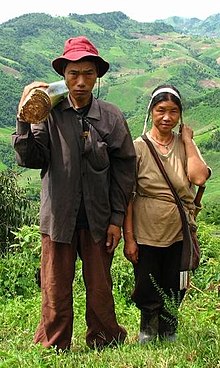An pagkakaiba han mga rebisyon han "Tawo"
No edit summary |
No edit summary |
||
| Bagis 3: | Bagis 3: | ||
| name = ''Homo sapiens'' |
| name = ''Homo sapiens'' |
||
| status = LC |
| status = LC |
||
| image = |
| image = Akha cropped hires.JPG |
||
| image_caption = |
| image_caption = |
||
| domain = |
| domain = |
||
Pagbabag-o han 16:06, 9 Marso 2018
| Homo sapiens | ||||||||||||||||||
|---|---|---|---|---|---|---|---|---|---|---|---|---|---|---|---|---|---|---|
 | ||||||||||||||||||
| Kahimtang han Pagpapabilin | ||||||||||||||||||
| Siyentipiko nga pagklasipika | ||||||||||||||||||
| ||||||||||||||||||
| Binomial nga ngaran | ||||||||||||||||||
| Homo sapiens Linnaeus, 1758 |
An Homo sapiens[2][3][4][5][6][7] (Inlatino:Homo Sapien) (Pambansa:Tao) in uska species han Primates nga ginhulagway ni Linnaeus hadton 1758. An Homo sapiens in nahilalakip ha genus nga Homo, ngan familia nga Hominidae.[8][9] Ginklasipika han IUCN an species komo diri gud kababarak-an.[1] Waray hini subspecies nga nakalista.[8]
Hindiru
Lalaki:Male (Masculine)
Babayi:Female (Feminine)
Lisbiyana :Other Female (Lesbian)
Bayut :Other Male (Gay)
Klasipikasyun (Iningles:Classification)
Ulitawu: (Iningles:Guy/Teenager) (Pambansa:Binata) 13-19
Ulitawuhay: (Iningles:Early Teen) (Pambansa:Binatilyo) 10-12
Daraga: (Iningles:Gal/Teenager)(Pambansa:Dalaga) 13-19
Daragita: (Iningles:Early Teen) (Pambansa:Dalagita) 10-12
Lalakihay (Iniŋgles:Male Toddler) (Pambansa:Bouy) 9-6
Babayihay (Iningles: Female Toddler) (Pambansa:Ine/Naene) 9-6
Binata (Iningles: Kid) (Pambansa:yyyyyyy) 5-2
Bata (Iningles:Baby) (Pambansa:Bata) 1
yyyyyyy (Iningles:Infants) (Pambansa:yyyyyyyy) 0.16996 - 0.99
zzzzzzzzzzzzzz (Iningles:Fetus) (Pambansa:yyyyyyy) <0>
Mistress: May asawa nga lalaki
Mister: May asawa nga babayi
Pinanbasaran
- ↑ 1.0 1.1
"Homo sapiens". IUCN Red List of Threatened Species. Version 2012.2. International Union for Conservation of Nature. 2008. Ginkuhà 24/10/2012. Check date values in:
|accessdate=(help) - ↑ (1996) , database, NODC Taxonomic Code
- ↑ Banks, R. C., R. W. McDiarmid, A. L. Gardner, and W. C. Starnes (2003) , Checklist of Vertebrates of the United States, the U.S. Territories, and Canada
- ↑ Wilson, Don E., and DeeAnn M. Reeder, eds. (1992) , Mammal Species of the World: A Taxonomic and Geographic Reference, 2nd ed., 3rd printing
- ↑ (1998) , website, Mammal Species of the World
- ↑ Wilson, Don E., and F. Russell Cole (2000) , Common Names of Mammals of the World
- ↑ Banks, R. C., R. W. McDiarmid, and A. L. Gardner (1987) Checklist of Vertebrates of the United States, the U.S. Territories, and Canada, Resource Publication, no. 166
- ↑ 8.0 8.1 Bisby F.A., Roskov Y.R., Orrell T.M., Nicolson D., Paglinawan L.E., Bailly N., Kirk P.M., Bourgoin T., Baillargeon G., Ouvrard D. (red.) (2011). "Species 2000 & ITIS Catalogue of Life: 2011 Annual Checklist". Species 2000: Reading, UK. Ginkuhà 24 september 2012. Check date values in:
|accessdate=(help)CS1 maint: multiple names: authors list (link) - ↑ ITIS: The Integrated Taxonomic Information System. Orrell T. (custodian), 2011-04-26
Dugang nga barasahon
- Freeman, Scott; Jon C. Herron, Evolutionary Analysis (4th ed.) Pearson Education, Inc., 2007. ISBN 0-13-227584-8 pages 757–761.
Mga sumpay ha gawas
| Dugang nga pamiling mahitungod han Humans ha kanan Wikipedia mga bugto nga proyekto: | |
| Mga kasirigngon tikang ha Wiktionary | |
| Mga hulád tikang ha Wikiquote | |
| Mga imahe ngan medya tikang ha Commons | |
| Listahan han mga espesye Homo sapiens tikang ha Wikispecies | |
- Archaeology Info
- Homo sapiens – The Smithsonian Institution's Human Origins Program
- Homo sapiens Linnaeus, 1758 ha Encyclopedia of Life
- View the human genome on Ensembl

